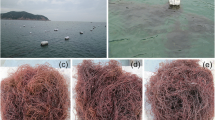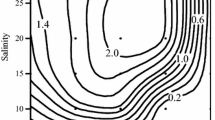Abstract
A complex study of the influence of various environmental factors on the rate of the oxygen (MO 2), ammonium (MNH 4), and phosphate (MPO 4) metabolism in Ahnfeltia tobuchiensis has been carried out in situ in the Izmena Bay of Kunashir Island. The following environmental factors have been included into the investigation: the photosynthetically active radiation (PAR); the ammonium (NH4); the phosphate (PO4); and the tissue content of carbon (C), nitrogen (N), phosphorus (P), and chlorophyll a (Chl). The population of agar-containing seaweed A. tobuchiensis forms a layer with a thickness up to 0.5 m, which occupies about 23.3 km2; the population’s biomass is equal to 125000 tons. The quantitative assessment of the organic matter production and nutrient consumption during the oxygen metabolism (MO 2) has been carried out for the whole population. It has been shown that the daily rate depends on the PAR intensity, the seawater concentrations of PO4 and NH4, and the tissue content of N and P (r 2 = 0.78, p < 0.001). The daily NH4 consumption averages 0.21 μmol/(gDW h) and depends on the NH4 and O2 concentrations in the seawater and on the C and Chl a content in the algal tissues (r 2 = 0.64, p < 0.001). The daily PO4 consumption averages 0.01 μmol/(gDW h) and depends on the NH4 concentration in the seawater and on the P content in the algal tissues (r 2 = 0.40, p < 0.001).
Access this article
We’re sorry, something doesn't seem to be working properly.
Please try refreshing the page. If that doesn't work, please contact support so we can address the problem.
Similar content being viewed by others
References
G. M. Voskoboinikov, “Electron-Microscopic Study of Ahnfeltia tobuchiensis Cells from Different Parts of the Thallus,” in Biology of Ahnfeltia (DVNTS Akad. Nauk SSSR, Vladivostok, 1980), pp. 21–27 [in Russian].
N. Draiper and G. Smit, Applied Regression Analysis (Statistika, Moscow, 1973) [in Russian].
S. M. Zayarnaya, P. G. Krainyuk, V. I. Ryabushko, and T. S. Tarasova, “Determination of Oxygen, Oxidation, and Salinity,” in Methods of Chemical Analysis in Hydrobiological Studies (DVNTS Akad. Nauk SSSR, Vladivostok, 1979), pp. 44–62 [in Russian].
V. I. Zvalinskii, “Light and Temperature Conditions of Ahnfeltia Living in the Stark Strait, Sea of Japan,” in Biology of anfel’tsii (DVNTS Akad. Nauk SSSR, Vladivostok, 1980), pp. 28–34 [in Russian].
M. B. Ivanova, A. V. Novozhilov, and A. P. Tsurpalo, “Living Conditions and Some Features of Floro-Faunistic Structure of Exploitable Natural Fields of Ahnfeltia tobuchiensis in Stark Strait (Peter the Great Bay, Sea of Japan) and Izmena Bay (Kunashir Island, Kuril Islands),” in Basics of Aquaculture Biotechnology in the Far East of Russia (Izv. TINRO, Vladivostok, 1994), pp. 83–99 [in Russian].
V. F. Makienko, “The History of Study of Ahnfeltia plicata (Huds): Ahnfeltia Species near Far-East Coasts of the USSR,” in Biology of Ahnfeltia (DVNTS Akad. Nauk SSSR, Vladivostok, 1980), pp. 5–14 [in Russian].
A. V. Novozhilov, “Influence of Hydrodynamic Conditions on the Structure and Productivity of Natural Fields of Ahnfeltia tobuchiensis,” Extended Abstract of Candidate’s Dissertation in Biology (Vladivostok, 1989).
E. P. Odum, Basic Ecology (Saunders, Philadlelphia, 1983; Mir, Moscow, 1986).
L. I. Popova, I. I. Cherbadgy, and D. A. Nekrasov, “Hydrochemical Living Conditions of Populations of the Red Alga Ahnfeltia tobuchiensis in the Izmena Bay (Kunashir Island),” Biol. Morya 26(5), 332–338 (2000).
L. N. Propp, S. D. Kashenko, and M. V. Propp, “Determination of Main Nutrients,” in Methods of Chemical Analysis in Hydrobiological Studies (DVNTS Akad. Nauk SSSR, Vladivostok, 1979), pp. 63–88 [in Russian].
M. V. Propp and L. N. Propp, “Hydrochemical Bases of Primary Production in the Coastal Area of the Sea of Japan,” Biol. Morya, No. 1, 29–37 (1981).
M. V. Propp and L. N. Propp, “Hydrochemical Indices and Chlorophyll a Content in Water of the Coastal Area near Kuril Islands,” Biol. Morya, No. 4, 68–70 (1988).
E. A. Titlyanov, A. V. Novozhilov, and I. I. Cherbadgy, Ahnfeltia tobushiensis: Biology, Ecology, and Productivity (Nauka, Moscow, 1993) [in Russian].
K. M. Khailov and V. P. Parchevskii, Hierarchical Regulation of Structure and Function of Marine Plants (Naukova Dumka, Kiev, 1983) [in Russian].
I. I. Cherbadgy and E. A. Titlyanov, “Biology, Ecology and Productivity of the Red Alga Ahnfeltia tobushiensis,” Biol. Morya 24(2), 71–81 (1998).
I. I. Cherbadgy and L. I. Popova, “Effect of Environmental Factors on Oxygen Exchange in the Population of Ahnfeltia tobuchiensis (Kanno et Matsubara) Mak. (Ahnfeltiales, Rhodophyta),” Algologiya, No. 2, 222–233 (2002).
I. I. Cherbadgy, L. I. Sabitova, and V. A. Parenskii, “Influence of Environmental Factors and Concentration of Nutrients in Tissues of the Algae Ahnfeltia tobuchiensis (Rhodophyta: Ahnfeltiales) on Photosynthesis and Dark Respiration of Its Population,” Biol. Morya 36(4), 274–285 (2010).
M. J. Atkinson and S. V. Smith, “C: N: P Ratio of Benthic Marine Plants,” Limnol. Oceanogr. 28, 568–574 (1983).
N. G. Barr and T. A. Rees, “Nitrogen Status and Metabolism in the Green Seaweed Enteromorpha intestinalis: An Examination of Three Natural Populations,” Mar. Ecol.: Proc. Ser. 249, 133–144 (2003).
A. R. O. Chapman, “Nutrient Cycling in Marine Ecosystem,” J. Limnol. Soc. Sth. Afr. 12, 22–42 (1986).
I. I. Cherbadgy and L. I. Popova, “Distribution, Biomass and Primary Production of Ahnfeltia tobuchiensis Population in the Bay of Izmena, Kunachir Island,” Phycol. Res. 46, 1–10 (1998).
N. J. Conolly and E. A. Drew, “Physiology of Laminaria IV. Nutrient Supply and Daylength, Major Factors Affecting Growth of L. digitata and L. saccharina,” Mar. Ecol. 6, 299–320 (1985).
J. A. De Boer, The Biology of Seaweeds, Ed. by C. S. Lobban and M. J. Wynne (Blackwell Scientific, Oxford, 1981), pp. 356–392.
D. T. Dy and H. T. Yap, “Surge Ammonium Uptake of the Cultured Seaweed, Kappaphycus alvarezii (Doty) Doty (Rhodophyta: Gigartinales),” Exper. Mar. Biol. Ecol. 265, 89–100 (2001).
P. G. Falkowski and T. G. Owens, “Light-Shade Adaptation: Two Strategies in Marine Phytoplankton,” Plant. Physiol. 66, 592–595 (1980).
I. Hernandez, G. Peralta, J. L. Perez-Llorens, et al., “Biomass and Dynamics of Growth of Ulva Species in Pallmones River Estuary,” J. Phycol. 33, 764–772 (1997).
R. Hwang, C. Tsai, and T. Lee, “Assessment of Temperature and Nutrient Limitation on Seasonal Dynamics among Species of Sargassum from a Coral Reef in Southern Taiwan,” J. Phycol. 40, 463–473 (2004).
S. W. Jeffrey and G. F. Humphrey, “New Spectrophotometric Equations for Determining Chlorophylls a, b, c 1, and c 2 in Higher Plants, Algae and Natural Phytoplankton,” Biochem. Physiol. Pflanz. 167, 191–194 (1975).
B. E. Lapointe, M. M. Littler, and D. S. Littler, “Nutrient Availability to Marine Macroalgae in Siliciclastic versus Carbonate-Rich Coastal Waters,” Estuaries 15(1), 75–82 (1992).
B. E. Lapointe, P. J. Barile, M. M. Littler, et al., “Macroalgal Blooms on Southeast Florida Coral Reefs. I. Nutrient Stoichiometry of the Invasive Green Alga Codium isthmocladum in the Wider Caribbean Indicates Nutrient Enrichment,” Harmful algae 4, 1092–1105 (2005).
B. Martinez and J. M. Rico, “Seasonal Variation of P Content and Major N Pools in Palmaria palmate (Rhodophyta),” J. Phycol. 38, 1082–1089 (2002).
A. E. Maxwell, Multivariate Analysis in Behavioral Research (Chapman and Hall, London, 1977).
M. Menendez, J. Herrera, and F. A. Comin, “Effect of Nitrogen and Phosphorus Supply on Growth, Chlorophyll Content and Tissue Composition of the Macroalga Chaetomorpha linum (O.F. Mull.) Kutz in a Mediterranean Coastal Lagoon,” Sci. Mar. 66, 355–364 (2002).
M. F. Pedersen, “Transient Ammonium Uptake in the Macroalga Ulva lactuca (Chlorophyta): Nature, Regulation, and the Consequences for Choice of Measuring Technique,” J. Phycol. 30, 980–986 (1994).
M. F. Pedersen and J. Borum, “Nutrient Control of Algal Growth in Estuarine Waters. Nutrient Limitation and the Importance of Nitrogen Requirements and Nitrogen Storage among Phytoplankton and Species of Macroalgae,” Mar. Ecol.: Proc. Ser. 142, 261–272 (1996).
M. V. Propp, M. R. Garber, and V. J. Ryabushko, “Unstable Processes in the Metabolic Rate Measurement in Flow-Through System,” Mar. Biol. (Berlin) 67, 47–51 (1982).
J. Ramus, “Productivity of Seaweeds,” in Primary Productivity and Biogeochemical Cycles in the Sea, Ed. by P. G. Falkowski and A. D. Woodhead (Plenum, New York, 1992), pp. 239–255.
V. N. R. Rao and V. Selvarani, “Phosphate Uptake in Amphora coffeaeformis (Agardh) Kutz, Navicula pelliculosa (Breb.) Hilse and Thalassiosira fluviatilis Hustedt,” Phykos 28(1–2), 216–230 (1989).
A. C. Redfield, B. H. Ketchum, and F. A. Richards, “The Influence of Organisms on the Composition of Sea-Water,” In the Sea, Ed. by M. N. Hill (Wiley Interscience, New York, 1963), Vol. 2, pp. 26–77.
J. D. H. Strickland and T. R. Parsons, “A Manual of Sea Water Analysis,” Bull. Fisher. Res. Board. Can. No. 125 (1972).
P. J. Syrett, “Nitrogen Metabolism of Microalgae,” Physiological Bases of Phytoplankton Ecology. Can. Bull. Fish Aquaat. Sci. 210, 182–210 (1981).
D. H. Turpin, “Effects of Inorganic N Availability on Algal Photosynthesis and Carbon Metabolism,” J. Phycol. 27, 14–20 (1991).
P. A. Wheeler and Bo. R. Bjornsater, “Seasonal Fluctuations in Tissue Nitrogen, Phosphorus, and N: P for Five Macroalgal Species Common to the Pacific Northwest Coast,” J. Phycol. 28, 1–6 (1992).
B. E. Young, M. J. Dring, G. Savidge, et al., “Seasonal Variation in Nitrate Reductase Activity and Internal N Pools in Intertidal Brown Algae Are Correlated with Ambient Nitrate Concentrations,” Plant Cell Environ. 30, 764–774 (2007).
Author information
Authors and Affiliations
Corresponding author
Additional information
Original Russian Text © I.I. Cherbadgy, L.I. Sabitova, 2011, published in Okeanologiya, 2011, Vol. 51, No. 1, pp. 54–64.
Rights and permissions
About this article
Cite this article
Cherbadgy, I.I., Sabitova, L.I. Influence of the environmental factors on the intensity of the oxygen, ammonium, and phosphate metabolism in the agar-containing seaweed Ahnfeltia tobuchiensis (Ahnfeltiales, Rhodophyta). Oceanology 51, 49–59 (2011). https://doi.org/10.1134/S0001437011010024
Received:
Accepted:
Published:
Issue Date:
DOI: https://doi.org/10.1134/S0001437011010024




